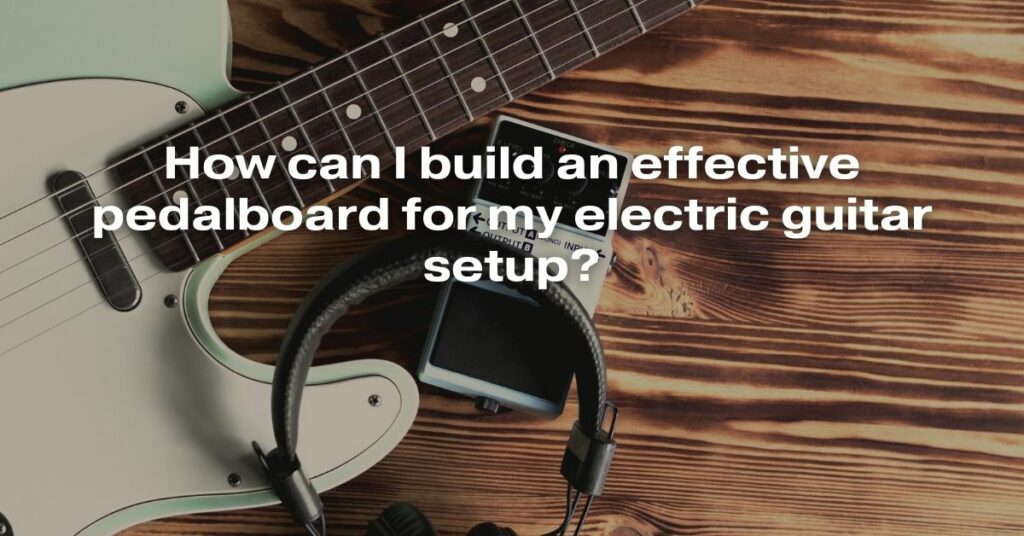Creating a personalized and efficient pedalboard is a crucial step for any electric guitar enthusiast. Whether you are a beginner or an experienced musician, the right combination of pedals can significantly enhance your sound and elevate your playing experience. In this comprehensive guide, we will explore the essential steps to help you build an effective pedalboard tailored to your unique style and preferences.
1. Understand Your Playing Style
The first and most important step in building an effective pedalboard is understanding your playing style. Consider the genre you primarily play, whether it’s blues, rock, metal, or something else entirely. Different styles demand different effects, so identifying your niche will guide your pedal selection.
2. Start with the Basics
Begin your pedalboard journey with fundamental pedals that form the core of any setup:
Tuner Pedal: Ensures your guitar is always in tune.
Overdrive/Distortion Pedal: Provides the grit and crunch for rock and metal styles.
Delay Pedal: Adds depth and ambiance to your sound.
Reverb Pedal: Creates a sense of space and atmosphere in your playing.
Compressor Pedal: Evens out your playing dynamics and sustains notes.
3. Experiment with Modulation Effects
Once you have the basics, explore modulation effects like:
Chorus Pedal: Adds a shimmering, rich texture to your sound.
Phaser Pedal: Creates a swirling, hypnotic effect.
Flanger Pedal: Produces a jet-like swooshing sound.
Tremolo Pedal: Modulates your volume, creating a pulsating effect.
Experimenting with these effects will help you discover the nuances they bring to your playing, allowing you to decide which ones complement your style.
4. Prioritize Quality Over Quantity
While it can be tempting to fill your pedalboard with numerous effects, quality should always come first. Invest in durable, reliable pedals from reputable manufacturers. High-quality pedals ensure your sound remains pristine and interference-free, even during live performances.
5. Plan Your Pedalboard Layout
Carefully plan the arrangement of your pedals to optimize functionality and accessibility. Consider the following tips:
Signal Chain: Generally, the signal should flow from your guitar into the tuner, followed by compression, overdrive, modulation, delay, and reverb pedals. Experiment with the order to find the best sound for your setup.
Power Supply: Use a reliable power supply to avoid noise interference. Daisy-chain power cables or invest in a dedicated power source for each pedal.
Cable Management: Use high-quality patch cables to connect your pedals, keeping the layout neat and minimizing signal loss.
6. Customize Your Pedalboard
Personalize your pedalboard based on your needs. Consider additional pedals like:
Looper Pedal: Allows you to record and play back loops, enhancing your solo performances.
Wah Pedal: Adds expressive, vocal-like tones to your playing.
Volume Pedal: Controls your guitar’s volume without changing your tone.
EQ Pedal: Shapes your sound by adjusting specific frequencies.
Customizing your setup ensures it caters to your unique playing requirements, making your pedalboard an extension of your musical expression.
7. Seek Inspiration and Guidance
Don’t hesitate to seek inspiration from your favorite guitarists or online communities. Watch videos, read articles, and participate in forums to learn about different pedal combinations and techniques. Musicians’ experiences can offer valuable insights into creating your ideal pedalboard.
Conclusion
Building an effective pedalboard for your electric guitar setup is a rewarding journey that enhances your creativity and performance. By understanding your playing style, starting with essential pedals, prioritizing quality, planning your layout, customizing your setup, and seeking inspiration, you can create a pedalboard that not only reflects your personality but also elevates your musical prowess. Remember, the key is to experiment, stay open to new ideas, and most importantly, have fun crafting your unique sonic identity. Happy playing!


